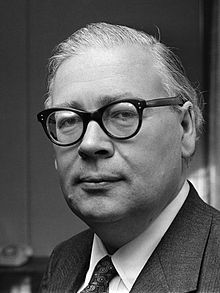Geoffrey Rippon
|
The Right Honourable The Lord Rippon of Hexham PC QC |
|
|---|---|
 |
|
| Shadow Foreign Secretary | |
|
In office 4 March 1974 – 11 February 1975 |
|
| Leader | Ted Heath |
| Preceded by | Jim Callaghan |
| Succeeded by | Reginald Maudling |
| Secretary of State for the Environment | |
|
In office 5 November 1972 – 4 March 1974 |
|
| Prime Minister | Ted Heath |
| Preceded by | Peter Walker |
| Succeeded by | Tony Crosland |
| Chancellor of the Duchy of Lancaster | |
|
In office 25 July 1970 – 5 November 1972 |
|
| Prime Minister | Ted Heath |
| Preceded by | Anthony Barber |
| Succeeded by | John Davies |
| Minister of Technology | |
|
In office 20 June 1970 – 25 July 1970 |
|
| Prime Minister | Ted Heath |
| Preceded by | Tony Benn |
| Succeeded by | John Davies |
| Shadow Secretary of State for Defence | |
|
In office 1969 – 20 June 1970 |
|
| Leader | Ted Heath |
| Preceded by | Reginald Maudling |
| Succeeded by | George Thomson |
| Member of Parliament for Hexham |
|
|
In office 31 March 1966 – 11 June 1987 |
|
| Preceded by | Rupert Speir |
| Succeeded by | Alan Amos |
| Member of Parliament for Norwich South |
|
|
In office 26 May 1955 – 15 October 1964 |
|
| Preceded by | Henry Strauss |
| Succeeded by | Christopher Norwood |
| Personal details | |
| Born |
28 May 1924 Penn, England |
| Died | 28 January 1997 (aged 72) Broomfield, England |
| Political party | Conservative |
| Alma mater | Brasenose College, Oxford |
Aubrey Geoffrey Frederick Rippon, Baron Rippon of Hexham, PC, QC (28 May 1924 – 28 January 1997) was a British Conservative politician. He was Chairman of the European-Atlantic Group.
Born in Penn, Buckinghamshire, the son of the Somerset cricketer Sydney Rippon, Geoffrey Rippon was educated at King's College, Taunton, and Brasenose College, Oxford, where he was president of the University Conservative Association. He was called to the Bar in 1948 and was Mayor of Surbiton 1951–52 and a member of the London County Council from 1952.
After unsuccessfully contesting the seat of Shoreditch and Finsbury in both 1950 and 1951, he became MP for Norwich South in 1955.
As Minister for Public Building and Works in 1962, Rippon controversially sought to demolish and redevelop the Italianate Foreign and Commonwealth Office main building designed in the 1860s by Sir George Gilbert Scott. After campaign led by the Victorian Society and a public outcry the decision was overturned and the building was subsequently granted Grade 1 listed building status.
...
Wikipedia
